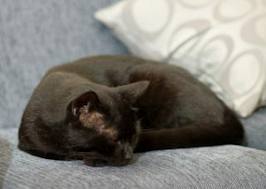Late summer/early autumn is a time when many people return to school or work; it spells the resumption of regular activities after the summer holiday. In Scandinavia (and other places, such as the Tyrol area near the Alps), it means that the young people will be bringing the herds home from the summer pastures.
The word seter (
sæter in Norwegian) can refer not only to the mountain pastures where the herds were grazed in summer and where butter and cheese were made, but also to the small hut or cabin which the dairymaids used as shelter for themselves and their equipment. Up until recent times, the family would send their young men and women up into the mountains during the summer with the herds of cows and goats (a sort of working summer camp), where they would live alone at the seter for several weeks or months at a time. In some places, there were actually local laws against not sending your herds up to graze in summer--with the short growing season, it was important that the community's animals get the benefit of the better grazing on the summer pastures, and also this practice kept the pastureland closer to home from becoming over-grazed.
Because the tasks of milking and making butter and cheese were the traditional province of women, it was often young women and girls who were sent, and they would actually make the year's cheese and butter form the milk their animals produced throughout the summer. These activities, as so many things that seem to depend on luck for success, were tinged with magic and mystery. Butter was not only a valuable commodity for the human community, it was also highly prized by supernatural beings. For example, it was important to give a gift of butter at Yule to the family's household spirit, the
nisse (or
kobold in Sweden), to ensure its cooperation for the coming year.
The magical qualities of butter, like those of ale and bread, partly arose from the uncertainly involved in making it. Despite the dairymaid's care, any number of disasters could occur during the process--the cow might not produce, the milk might be sour, or the butter might fail to churn. Nowadays such calamities are assigned to improper cream temperature or low fat content, but in the past people could only assume that the cause was either lack of luck or supernatural interference. Therefore, the dairy was surrounded by as much ritual as the brewery or bakery.
Huldra is the Scandinavian patron of cattle grazing and milking. This goddess sometimes appears armed with a milk pail and leading her flock. She is also said to have a cow's tail, which she takes great pains to conceal. Huldra and her elves were apt to visit the summer pasture grounds. She loved music and dancing and would often try to join in the summer dances disguised as a maiden, until she is inevitably betrayed by her tail poking up from under her skirts.
Less friendly entities might also visit the dairymaids and herdsmen in the summer pastures, and there are a number of folktales and songs which tell of a young person being accosted by trolls in the seter, especially around Midsummer, a particularly magical time. The Three Billy Goats Gruff in the folktale encounter the troll under the bridge while returning from the summer pastures.
When the young people returned home, it must have been a joyous time. Although their parents might have been secretly relieved to get their adolescents out of the house for a few months, by the end of summer they would be missing their liveliness and cheer. The families would bake fresh bread to welcome the returning youths, a food they would have been without up at the seter, and for their part, the young people would bring home all the fresh butter and cheese they had been making during the summer. The empty huts were left for the elves to enjoy for the winter, until the herds returned again.










